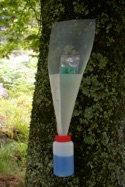The Fan-trap
Developed by Jean-Claude Grégoire, Emilio Caiti, Séverine Hasbroucq, Jean-Marc Molenberg and Sylvain Willenz
Description
Monitoring is an important component of pest management, to prevent or mitigate outbreaks of native pests, and to check for quarantine organisms. Surveys often rely on trapping, especially when the target species respond to semiochemicals. Many traps are available for this purpose, but they are bulky in most cases, which raises transportation and deployment issues, and they are expensive, which limits the size and accuracy of any network.
To overpass these difficulties, entomologists have used recycled material, such as modified plastic bottles, producing cheap and reliable traps but at the cost of recurrent handywork, not necessarily possible for all end-users (e.g., for national plant protection organizations). These bottle-traps have allowed very large surveys which would have been impossible with standard commercial traps, and we illustrate this approach with a few examples.
Here we present, under a Creative Commons BY-SA License, the blueprint of a fan-trap, a foldable model, laser-cut from a sheet of polypropylene, that can rapidly be produced in large numbers, and could be transported and deployed in the field with very little efforts. Our first field comparisons show that fan-traps are as efficient as bottle-traps, and we describe two cases where they are being used for monitoring.
How to cite
Grégoire J-C, Caiti E, Hasbroucq E, Molenberg J-M, Willenz S (2022) When the beetles hit the fan. The Fan-trap, an inexpensive, light and scalable insect trap under a Creative Commons License, for monitoring and experimental use. Insects 13: 1122.
Description and blueprint
-
Fantrap_Description.pdf
-
Fantrap_Blueprint.zip




















